Fisheries and Aquaculture Journal
Open Access
ISSN: 2150-3508
ISSN: 2150-3508
Research Article - (2021)
Cast net (Locally called veesu vala) design variation, operational techniques, catch composition and selectivity analysis in vembanad wetland, Kerala was examined between June 2020 to April 2021. Netting materials used for cast net construction in vembanad Lake were monofilament, multifilament Nylon (polyamide). The cast net length was 4-5 m and net mouth area was 2.5-5.0 m2. Cast net was somewhat species specific and showed selectivity for shallow water species. Its durability ranged from 3.5 months to 3 years depending on the netting material and the environmental conditions where it is being operated. Cast net fishery is one of the main type of artisanal fishery practiced occupationally by the fishermen community of Kerala. The region so far is untouched with the introduction of mechanized fishing apart from small traditionalized improvements. The cast net was used to catch the fishes of marketable size, small fingerlings which were either used as bait or dried.
Cast net; Design variation; Catch composition; Selectivity
Vembanad is one of the largest tropical wetland system which is spread over 2,033 km, is bordered by the Alappuzha, Kottayam and Ernakulam districts of Kerala. It is the second largest brackish water arrangement of South India having a catchment space of 14500 km2. The area is profoundly broadened by the estuaries, tidal ponds, swamps, mangroves and a portion of the other manmade assets. The geographical location of the wetland is ascertained by its (latitude 9.510N–10.190N and longitude 76.160E–76.430E). The Lake was additionally assigned as a wetland of international significance under the Ramsar Convention in 2002 and a critically vulnerable coastal region subsequent to perceiving it's environmental significance as an indispensable ecosystem service provider and an essential habitat to diversified range of flouras and faunas. The lake opens to the Arabian Sea (max. depth : 4652 m ) in two locations, one at Azhikode ( 11.91710N, 75.33540E) which is at least 100 m wide and fairly deep, and the other at Cochin( 9.93120N, 76.26730E) which is 450 m wide. The lake has been divided into two zones viz. a freshwater dominant southern zone and a salt water dominant northern zone by the construction of a manmade barrier called Thanneermukkom barrage. The lake support wide range of fresh, saline and marine water species which contain 150 fish species having a place with 100 genera and 56 families [1,2]. The region is noted for two fishery resources, specifically black clam (Villorita cyprinoides) and Pearl spot (Etroplus suratensis (Bloch 1790)) (Figure 1).
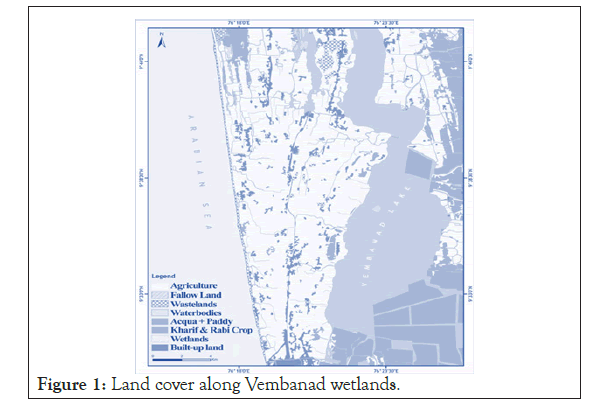
Figure 1: Land cover along Vembanad wetlands.
Cast nets or falling nets are one of the oldest and efficient way of fishing in kerala in which the fishermen throws the net over the water surface where catch is expected. It is used to catch small to medium sized fishes. Unlike other fishing gears, it can be operated through one hand. It was observed that only skilled strong personals with great sense of balance in canoe can effectively operate this type of gears. It had a weight of around 5 to 8 kilograms. It can weigh up to 8 to 20 kilograms with catch. During the study, cast net with different mesh size variation according to the species selectivity were encountered. There are mainly two types of nets viz. large size nets having a mesh size of 50 to 60 mm which used to catch Etroplus suratensis, Mugil cephalus Linnaeus, Lutjanus argentimaculatus (Forsskål), Oreochromis niloticus (Linnaeus), Horabagrus brachysoma (Günther), Epinephelus diacanthus (Valenciennes) etc. whereas small size net with 10 to 28 mm are mainly used with, Pseudetroplus maculatus (Bloch), Leiognathus equulus (Forsskål ), Eubleekeria splendens, Secutor insidiator (Bloch), Ambassis ambassis (Lacepède), and shrimps including Fenneropenaeus indicus, Penaeus monodon, Metapenaeus monoceros, Macrobrachium rosenbergii etc. There is significant improvement on the use of sinkers since fishermen began to use stainless steel hollow oval chains as sinkers instead of lead or galvanized irons. Use of stainless steel chain sinkers is efficient in their operation with better durability, corrosion resistance, and less expensive method of use [3].
Typically cast nets are worked by people in whom one man cast the net and other aides in gathering the catch and clearing the net from debris before the following toss. The fishermen subsequent to tossing the net, hang tight for two to five minutes and are then gradually pulled up. Two types of cast nets (stringed and stringless) are operated along the research area. Most commonly they were used to carry stringed ones (Figure 2).
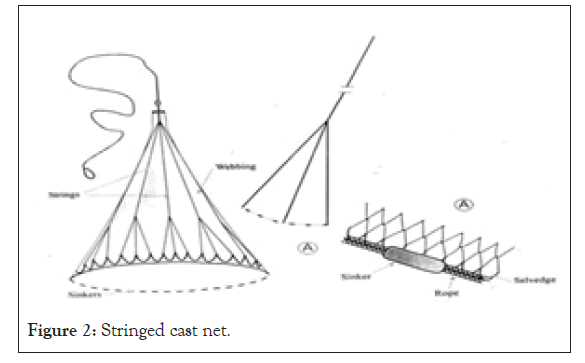
Figure 2: Stringed cast net.
These gears have a central line for pulling the net. On account of stringed assortment, the central line fans out into a several strings prior to arriving at the external edge of the net. They frame various pockets at the margin when the net is arranged and pulled up. In the last mentioned, the pockets are fixed by attaching the lower end network of meshes with twins so that there is no more connection between central line and these pockets. The net sinks under the water by the weights got to the external lower fringe of the net and the fishes or shrimp underneath the net are caught. The catch per unit effort is significantly influenced by the handling skills in which only fishermen with good balance and skills to throw the net in such a manner that it fall flat so as to have maximum coverage upon the water surface either from the shore or from a canoe. Depending on their needs and wants, they were supposed to use other fish congregating techniques like torch light flashing, feed spraying in water prior to fishing to concentrate more shrimps and fishes etc. Coconut wastes are also used to attract the shrimp before the net is cast from boats. After hauling the net, it combines inwards due to the weights. Then the fishermen remove the entangled fishes and shrimps and kept in baskets or directly to the canoes.
Though there were no changes in the traditional design apart from the selective use of sinkers. In the shore of Vembanad, it was clear to see that fishers attempted an assortment of materials by fabricating the upper segment of the cast net with multifilament which works with simple taking care of and holding the net. The lower monofilament material increment their getting effectiveness (catching efficiency). Now a days lots and lots of fish sampling practices under the supervision of NGOs, government and private agencies where going in the vicinity of vembanad wetlands [4]. Fast saw that in aquaculture, cast netting was not a lot of productive regarding kg reaped per each man hour, yet it very well may be savvy where work is economical. The cast net of vembanad wetlands were made up of 8 to 10 panels joined together vertically to form main conical webbing. Since hand braiding requires parcel of time, fishers were switched over to the machine made netting for fabricating the cast net. Machine made netting was shaped by cutting and panels were combined after fitting take up proportions. On account of hand braiding, the net is brought to shape by one or the other baiting or creasing at fitting stretches. In Vemband, PA monofilament having diameter of 0.13 to 0.23 mm was commonly used for construction of main webbing of cast net (Table 1).
| No of meshes | Mesh size (mm) | Mesh opening (mm) | Mesh circumference (mm) |
Material | ||
|---|---|---|---|---|---|---|
| Panel | In length | In depth | ||||
| 1 | 200 | 8 | 50 | 49 | 108 | |
| 2 | 266 | 10 | 50 | 49 | 108 | PA |
| 3 | 388 | 10 | 50 | 49 | 108 | monofilament |
| 4 | 632 | 10 | 50 | 49 | 108 | (Nylon) 0.23 mm |
| 5 | 1120 | 12 | 50 | 49 | 108 | 0.23 mm |
| 6 | 2096 | 12 | 50 | 49 | 108 | |
| 7 | 2584 | 20 | 50 | 49 | 108 | |
| 8 | 2838 | 20 | 50 | 49 | 108 | |
| Sl. No. | Other design characteristic | Measurements and description |
||||
| 1 | Gear color | White | ||||
| 2 | Type of Mesh net | Knotted | ||||
| 3 | Hand line rope length; material and diameter | 4.80 m; Polyethylene; 2 mm |
||||
| 4 | Foot rope length; material and diameter | 5.60 m; Kuralon; 3 mm |
||||
| 5 | Material of sinkers | Lead (Pb), Stainless steel, iron |
||||
| 6 | Weight of sinkers | 20- 25 g | ||||
| 7 | Shape of sinkers | Spindle , hollow oval (chain) |
||||
| 8 | Diameter of sinker (mm) | 5-6 | ||||
| 9 | Length of sinker (cm) | 5-7 | ||||
| 10 | Color of sinker | White, grey | ||||
| 11 | Total number of sinkers | 150 | ||||
| 12 | Distance between sinkers | 33.33 mm | ||||
| 13 | Average weight of cast net | 5 kg | ||||
| 14 | Circumference of net mouth | 5.60 m ( usually 5-10 m) |
||||
| 15 | Length of net | 5.1 m | ||||
| 16 | Area of net mouth | 2.5 square meter | ||||
Table 1: Cast net design and specification (Fish caught).
The selvedge in top segment of the net is fixed to a metal ring sinkers (typically lead) are connected to the base selvedge of the net. Along the vembanad coast, fishermen used to carry cast net having a mesh size ranging 10 mm to 55 mm depending on the type of fish as they want to catch. Cast net for fishes have a total of 200 to 204 numbers of meshes in the upper (Apex) and lower edge of first panel. The number mesh in depth was 8 in first panel. At the Apex, all meshes were shut together and were attached to the pulling string or chord. For panel 2, upper edge and lower edge meshes varied from 266 to 268. There were 10 numbers of meshes in depth for this panel. There were about 388 to 390 meshes with 10 mesh depth were found in panel 3, While panel 4 has 632 to 634 meshes and having a depth wise estimate of 10 mesh numbers. Panel 5 was constructed with 1120 to 1124 meshes in length and with 12 meshes depth. Out of total 8 panels, panel 6 also has 12 mesh depth and having 2096 to 2098 meshes in length. For panel 7, upper and lower edge meshes varied from 2584 to 2588 and with 20 meshes in depth. The last panel 8 had 2838 to 2842 meshes with 20 meshes in depth. The first 6 panels are constructed with take up ratio of 1:2 which means that, one mesh of upper panel and two meshes of lower panel were joined by making knot. Panel 7 had a take up ratio of 1:4 and panel 8 with 1:2 again (Figure 3).
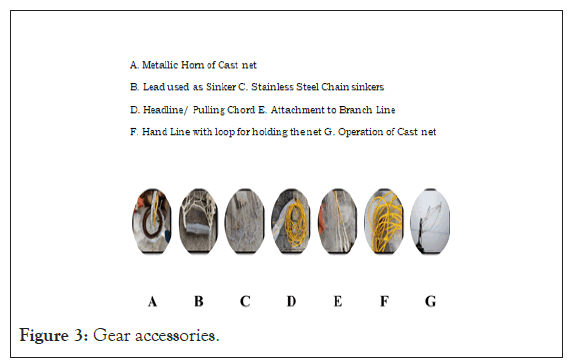
Figure 3: Gear accessories.
The total length of net varied from 4-5 meters and net mouth area of 2.5 m. The netting material was made with PA monofilament (Nylon) having a mesh size of 50 mm. Depending on their requirements, they used to carry 10 mm to 55 mm meshes. Small fishes and shrimps like P. monodon (Tiger shrimp, locally called Kara), P. indicus (White shrimp known as Naran) mainly caught with popular mesh size of 30-35 mm for tiger shrimp and 26-30 mm for white shrimps. Even though fishermen caught medium sized shrimps by using 10, 12 mm mesh size nets. Aside from the bigger size nets in marine fishing there is not any more critical contrast in the design specification of cast net in Vemband wetlands. In northern Kerala, Remesan tracked down that, main webbing of cast net were fabricated by hand utilizing PA 210 × D3 × 3 multifilament twine [5-7]. And the same twine is utilized to make the foot rope after hand twisting 13 to 15 twines. The length of foot rope was 5.60 m and made with kuralon 3 mm material. The hauling rope had a length of 4.8 m and made of polyethylene 2 mm material. There were significant variation in the design and selection of sinkers. In general, fishermen were selected lead (Pb), galvanized iron and stainless steel weights having a shape of spindle, oval, chain etc. Out of this, Use of stainless steel chains sinkers are effective in their operation with better durability, corrosion resistance, and less expensive method of use. The sinkers are constructed with a diameter of 5-6 mm and length ranging from 5-7 cm. The total 150 sinkers are positioned in such a manner so as to have spacing of 33.33 mm. Based on the study, the length of net was 5-7 meters with a circumference of 5.6 meters. On account of stringed cast nets, the main string which is held by hand is made of 3-4 mm diameter PP material. It branches into four or six strings and afterward each string is additionally divided into three or four strings which is joined to the base segment of the net where sinkers are appended. These strings are comprised of PA multifilament twines of fluctuating sizes relying on the size of the cast net (Table 2).
| Panel | No of meshes | Mesh size (mm) | Mesh opening (mm) | Mesh circumference (mm) | Material | |
|---|---|---|---|---|---|---|
| In length | In depth | |||||
| 1 | 260 | 12 | 28 | 27 | 54 | |
| 2 | 335 | 12 | 28 | 27 | 54 | |
| 3 | 433 | 13 | 28 | 27 | 54 | |
| 4 | 550 | 14 | 28 | 27 | 54 | PA monofilament |
| 5 | 650 | 14 | 28 | 27 | 54 | (Nylon) |
| 6 | 830 | 14 | 28 | 27 | 54 | |
| 7 | 1090 | 14 | 28 | 27 | 54 | |
| 8 | 1480 | 21 | 28 | 27 | 54 | |
| 9 | 1600 | 21 | 28 | 27 | 54 | |
| 10 | 1720 | 21 | 28 | 27 | 54 | |
| Sl.No. | Other design characteristic | Measurements and description | ||||
| 1 | Gear color | White | ||||
| 2 | Type of Mesh net | Knotted | ||||
| 3 | Hand line rope length; material and diameter | 4.80 m; Polyethylene; 2 mm | ||||
| 4 | Foot rope length; material and diameter | 5.60 m; Kuralon; 3 mm | ||||
| 5 | Material of sinkers | Lead (Pb), Stainless steel, iron | ||||
| 6 | Weight of sinkers 25 g | 20- 25 g | ||||
| 8 | Diameter of sinker (mm) | 5-6 | ||||
| 8 | Diameter of sinker (mm) | 5-6 | ||||
| 8 | Diameter of sinker (mm) | 5-6 | ||||
| 9 | Length of sinker (cm) | 3.5–4.5 | ||||
| 10 | Color of sinker | White, grey | ||||
| 11 | Total number of sinkers | 120 | ||||
| 12 | Distance between sinkers | 66 mm | ||||
| 13 | Average weight of cast net | 5.50 kg | ||||
| 14 | Circumference of net mouth | 7.92 m | ||||
| 15 | Length of net | 4.36 m | ||||
| 16 | Area of net mouth | 4.99 square meter |
Table 2: Cast net design and specification (Shrimp caught).
Cast net for shrimps having a total length of 4.36 meters with an average net mouth area of 4.99 m. They have a mesh size of 28 mm and which are made with polyamide monofilament materials. Total there were 10 panels of which 260 to 264 number of meshes were found in upper (Apex) and lower edge of first panel. The number mesh in depth was 12 in first panel. At apex, all meshes were closed together and were tied to the pulling cord. For panel 2, upper edge and lower edge meshes varied from 335 to 338. There were 12 number of meshes in depth for this panel. There were about 433 to 438 meshes with 13 mesh depth were found in panel 3, While panel 4 has 550 to 555 meshes and having a depth wise estimate of 14 mesh numbers. Panel 5 was constructed with 650 to 654 meshes in length and with 14 meshes depth. Out of total 8 panels, panel 6 also has 14 mesh depth and having 830 to 834 mesh in length. For panel 7, upper and lower edge meshes varied from 1090 to 1094 and with 14 mesh in depth. The panel 8 had 1480 to 1484 meshes with 21 mesh in depth. For panel 9 and 10 there were 21 panels in depth and 1600 to 1604 and 1720 to 1724 meshes in length was found. The first 8 panels are constructed with take up ratio of 2:3 which means that, two mesh of upper panel and three meshes of lower panel were joined by making knot. Panel 9 had a take up ratio of 3:3 and panel 10 with 1:2 (Figures 4-7).
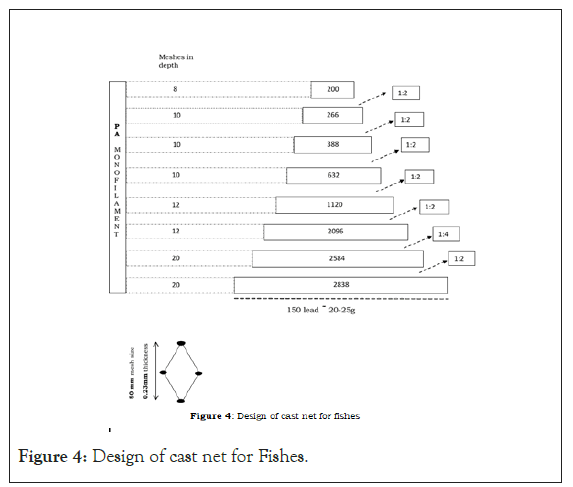
Figure 4: Design of cast net for Fishes.
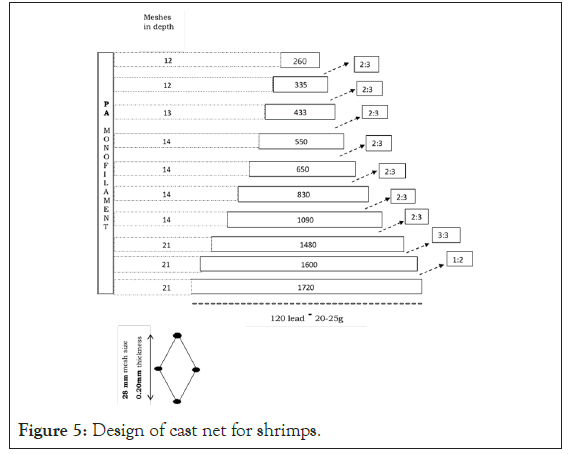
Figure 5: Design of cast net for shrimps.
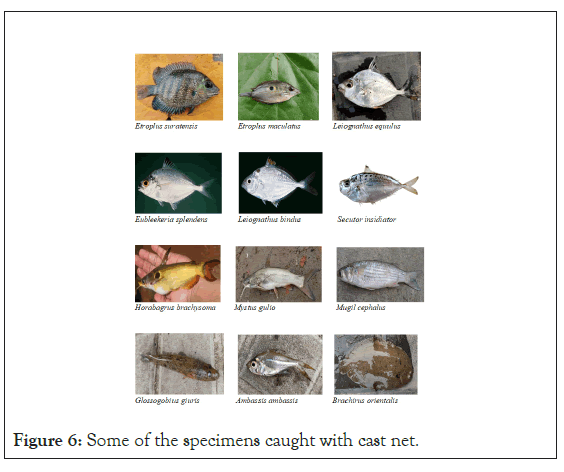
Figure 6: Some of the specimens caught with cast net.
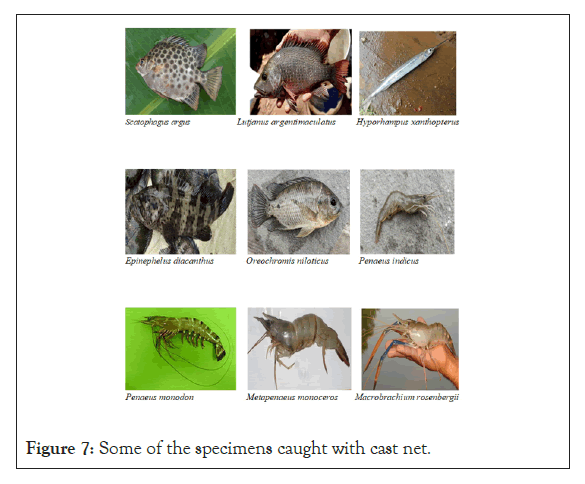
Figure 7: Some of the specimens caught with cast net.
The net was worked for the duration of the day either from the canoe or the bank of the lakes. The activity typically began in the early morning and last up to the night. The invasion of the aquatic weeds specifically Eichhornia crassipes (Mart.) Solms, Nelumbo nucifera Gaertn., Azolla pinnata and Nymphaea mexicana Zucc. was a significant threat to fishers in the investigation territory. Azolla pinnata and Eichornia crassipes have become spread inside a brief period broad in the water body and is discovered making a danger to other living things. These weed hinder the fishing action by ensnaring inside the cross sections of cast net. vembanad Lake is as yet under the inclusion of these weeds. By the examination, it was perceived that the issue can't addressed inside a brief timeframe since it can gravely influence the most extravagant environment of the lake and in turn the related services as it gives (Table 3).
| Scientific name | Common name | Vernacular name | Total length size range (cm) | Total depth size range (cm) | ||
|---|---|---|---|---|---|---|
| (Malayalam) | (Malayalam) | 1 | 1 | |||
| Etroplus suratensis | Pearl spot | Karimeen | 6.01-12.35 | 3.5-6.54 | ||
| Oreochromis niloticus | Nile tilapia | Pilopi | 14.0-18.5 | 4.31-6.53 | ||
| Leiognathus equulus | Common ponyfish | Mullan | 5.4-6.6 | 5.5-6.2 | ||
| Eubleekeria splendens Jones ponyfish | Jones ponyfish | Nalla mullan | 4.8-5.73 | 5.4-5.9 | ||
| Leiognathus bindus Orangefinned ponyfish | Orangefinned ponyfish | Moda mullan | 5.14-5.59 | 5.3-5.96 | ||
| Secutor insidiator | Pugnose ponyfish | Paarl-coorchee | 4.23-5.32 | 4-4.73 | ||
| Horabagrus brachysoma Yellow catfish | Horabagrus brachysoma Yellow catfish | Manjakkoori | 7.23-13.1 | 4.12-5.23 | ||
| Mystus gulio (Hamilton Long whiskered catfish | Mystus gulio (Hamilton Long whiskered catfish | Vellakkoori | 6.1-14.51 | 3.3-4.58 | ||
| Pseudetroplus maculatus Orange chromide | Pseudetroplus maculatus Orange chromide | Pallathi | 5.16-7.7 | 2.0-2.75 | ||
| Mugil cephalus Flathead grey mullet | Mugil cephalus Flathead grey mullet | Kanambu | 10.1-13.7 | 3.2-4.98 | ||
| Glossogobius giuris Tank goby | Glossogobius giuris Tank goby | Poolan | 7.12 -13.57 | 4.16-4.7 | ||
| Ambassis ambassis Commerson’s glassy | Ambassis ambassis Commerson’s glassy | Nandan | 3.7-5.9 | 1.7-2.3 | ||
| Brachirus orientalis (Bloch Oriental sole | Brachirus orientalis (Bloch Oriental sole | pattathi | 10.3 -12.56 | 5.0-6.23 | ||
| Scatophagus argus ((Linnaeus 1766) | Spotted scat | Nachhara | 6.37-7.57 | 5.1-6.53 | ||
| Lutjanus argentimaculatus | Mangrove red snapper | Chemballi | 11.36-15.37 | 6.8-7.5 | ||
| Hyporhamphus xanthopterus | Red tipped half beak | Kolaan | 10.36-13.85 | 1.1-2.01 | ||
| Epinephelus diacanthus | Spiny cheek grouper | Varayan kalawa | 7.36 -15.89 | 5.01-6.98 | ||
Species of shrimp caught with cast net |
||||||
| Scientific name | Common name | Vernacular name (Malayalam) |
Total body length (cm) | Total carapace length (cm) | ||
| Penaeus indicus | Indian white prawn | Naran chemmeen | 7.15-8.93 | 3.08-3.78 | ||
| Penaeus monodon | Giant tiger prawn | Kaara chemmeen | 7.36-10.32 | 3.08-4.53 | ||
| Metapenaeus monoceros | Speckled shrimp | Choodan chemmeen | 6.34-9.77 | 2.97-4.06 | ||
| Macrobrachium rosenbergii | Giant fresh water prawn | Attukonchu | 8.32-16.87 | 3.98-5.73 | ||
Table 3: Variation in sizes of fish and crustaceans caught with cast net in Vembanad lake.
Variation in daytime and nighttime fishing: fish and shrimp specimens caught with cast net
Based on the studies conducted, it was analyzed that Ambassis ambassis (commerson’s glassy, locally called Nandan ) was the dominant species that account for about 75-135 in number per each cast. Depending on the seasonal variations the average number of fish caught was 156 per trip. The average number of fish caught per hour was 77. The average number of fish caught per cast was 9 and the average number of cast per hour was 5. There was significant variation in the night time fishing activities. Fishers caught shrimps mainly during the night hours [8,9]. Shrimps like Penaeus indicus (Indian white prawn locally called Naaran), Penaeus monodon (Giant tiger prawn locally called Kaara), Metapenaeus monoceros (Speckled shrimp locally called choodan) and Macrobrachium rosenbergii (Giant fresh water prawn locally called Aatukonchu) dominantly caught during night hours using small mesh size of about 10-28 mm (Table 4).
| Order | Family | Species | Post-monsoon | Pre-monsoon | Monsoon |
|---|---|---|---|---|---|
| Pristolepidae | |||||
| Pristolepis rubripinnis Britz Kumar | no | yes | no | ||
| Leiognathidae | Leiognathus dussumeiri | yes | no | yes | |
| Leiognathus equulus | yes | yes | yes | ||
| Leiognathus splendens | no | yes | no | ||
| Leiognathus bindus | no | yes | no | ||
| Leiognathus brevirostris (Valenciennes, 1835) | yes | yes | yes | ||
| Secutor insidiator | yes | yes | no | ||
| Gazza minuta (Bloch 1795) | no | yes | no | ||
| Cichlidae | Pseudetroplus maculatus | yes | yes | no | |
| Perciformes | E. suratensis | no | no | yes | |
| Ambassidae | Ambassis ambassis | yes | yes | yes | |
| Parambassis sp. | yes | yes | yes | ||
| Gerridae | Gerres limbatus Cuvier, 1830 | yes | yes | yes | |
| Carangidae | Caranx ignobilis (Forsskål 1775) | no | yes | no | |
| Glossogobidae | Glossogobius giuris | yes | no | yes | |
| Lethrinidae | Lethrinus sp. | no | yes | no | |
| Lutjanidae | Lutjanus argentimaculatus | no | yes | yes | |
| Scatophagidae | Scatophagus argus | no | yes | yes | |
| Sillaginidae | Sillago sihama (Forsskål 1775) | no | yes | no | |
| Sciaenidae | Johnius dussumieri (Cuvier 1830) | no | yes | no | |
| Anabantidae | Anabas testudineus (Bloch 1792) | yes | no | no | |
| Channidae | Channa striata (Bloch, 1793) | yes | no | yes | |
| Channa marulius (Hamilton 1822) | yes | no | yes | ||
| Anabantiformes | Heteropneustidae | Heteropneustes fossilis (Bloch 1794) | no | no | yes |
| Clupeidae | Thryssa malabarica (Bloch, 1795) | no | no | yes | |
| Stolephorus indicus (Van Hasselt, 1823) | no | no | yes | ||
| Anodontostoma chacunda (Hamilton, 1822) | no | yes | no | ||
| Clupeiformes | Nematalosa nasus (Bloch, 1795) | no | yes | no | |
| Mystidae | Mystus malabaricus (Jerdon 1849) | no | no | yes | |
| Ariidae | Arius maculatus (Thunberg, 1792) | no | yes | no | |
| Siluridae | Ompok malabaricus (Valenciennes, 1840) | no | yes | no | |
| Siluriformes | Bagridae | Horabagrus brachysoma (Günther, 1864) | no | yes | yes |
| Hyporhamphidae | Hyporhamphus limbatus (Valenciennes 1847) | no | yes | yes | |
| Beloniformes | Belonidae | Xenentodon cancila (Hamilton 1822) | no | yes | yes |
| Mugilidae | Mugil cephalus Linnaeus 1758 | no | yes | no | |
| Mugiliformes | Liza tade (Forsskål, 1775) | yes | yes | yes | |
| Cynoglossidae | Cynoglossus macrostomus Norman, 1928 | yes | yes | no | |
| Pleuronectiformes | soleidae | Brachirus orientalis (Bloch and Schneider, 1801) | yes | no | yes |
| Cyprinidae | Dawkinsia filamentosa (Valenciennes, 1844) | no | yes | yes | |
| Gibelion catla (Hamilton 1822) | no | yes | no | ||
| Cypriniformes | Puntius sarana (Hamilton, 1822) | yes | yes | yes | |
| Puntius mahecola (Valenciennes, 1844) | no | yes | yes | ||
| Venerida | Cyrenidae | Villorita cyprinoides Gray 1825 | yes | yes | nil |
| Elopiformes | Megalopidae | Megalops cyprinoides (Broussonet, 1782) | yes | yes | yes |
Monsoon: June–September; Post-monsoon: October–January; Pre-monsoon: February–May. Absence represented by No and presence represented by Yes.
Table 4: Presence or absence: Table of species at Vembanad lake.
Financial analysis of cast net operation
All the fishers met promptly expressed that cast netting was profitable and that they were happy with work. In any case, it got such a large number of juvenile fishes with 4,5,6 cm in absolute length. So separated from the fisher's side, biologically cast nets are uneconomical. The ensnaring of aquatic weeds likewise gravely impacts their activity cost. Since they need more diesel or petroleum for running the canoe with outboard engine. As these weeds get caught in the nets, fishers feel faltered and it can harm the net and hence the catch per unit effort as well. The expense of rigging cast nets was around 2000 rupees. Yield cost or output cost was determined to be 200 rupees for each outing. It was expected to be that if fishing was accomplished for multiple times in a year, the yearly annual income would be between 55,000 to 75,000 rupees. The strength or durability of the net can be reached out from 3 months to 3 years depending up on its better maintenance. The durability of the outboard engine reaches from 4.5 years to 6 years, the durability of the canoes ranged from 8 years to 12.5 years.
Cast net fishing practice in vembanad wetlands is mainly undertaken by the fishermen while the fisherwomen were mostly involved in marketing i.e. selling the fish catch. Fisher women also engaged in various fishing activities including hand picking of black clam (Villorita cyprinoides), mussel farming, pearl spot farming with the financial assistance from department of fisheries, kudumbhasree units, society for assistance to fisherwomen (SAF) etc.
The recorded data on the technical specifications, catch composition, selectivity and operation of the conventional fishing technique for cast net rehearsed in vembanad wetlands, Kerala would serve as a base line information for the technological modifications the method may go through in the coming years.
Author wish to thank the authorities of Kerala University Of Fisheries And Ocean Studies, Panangad, 682505 Kerala, India (Mrs. Amrutha R krishnan) for giving the essential facilities, and their thoughtful support and direction throughout the investigation.
The authors declare that there is no conflict of interest.
There is no funding source available.
Citation: Ajay VS, Krishnan AR (2021) Design Characteristics and Specifications of Cast Net Operated Along the Lower Stretches of Vembanad Wetlands. Fish Aquac J. S2: 001.
Received: 03-May-2021 Accepted: 17-May-2021 Published: 24-May-2021 , DOI: 10.35248/2150-3508.21.s2.001
Copyright: © 2021 Ajay VS, et al. This is an open-access article distributed under the terms of the Creative Commons Attribution License, which permits unrestricted use, distribution, and reproduction in any medium, provided the original author and source are credited.